Tip jar
☕️ If you have enjoyed any of these resources, feel free to buy me a coffee.


☕️ If you have enjoyed any of these resources, feel free to buy me a coffee.


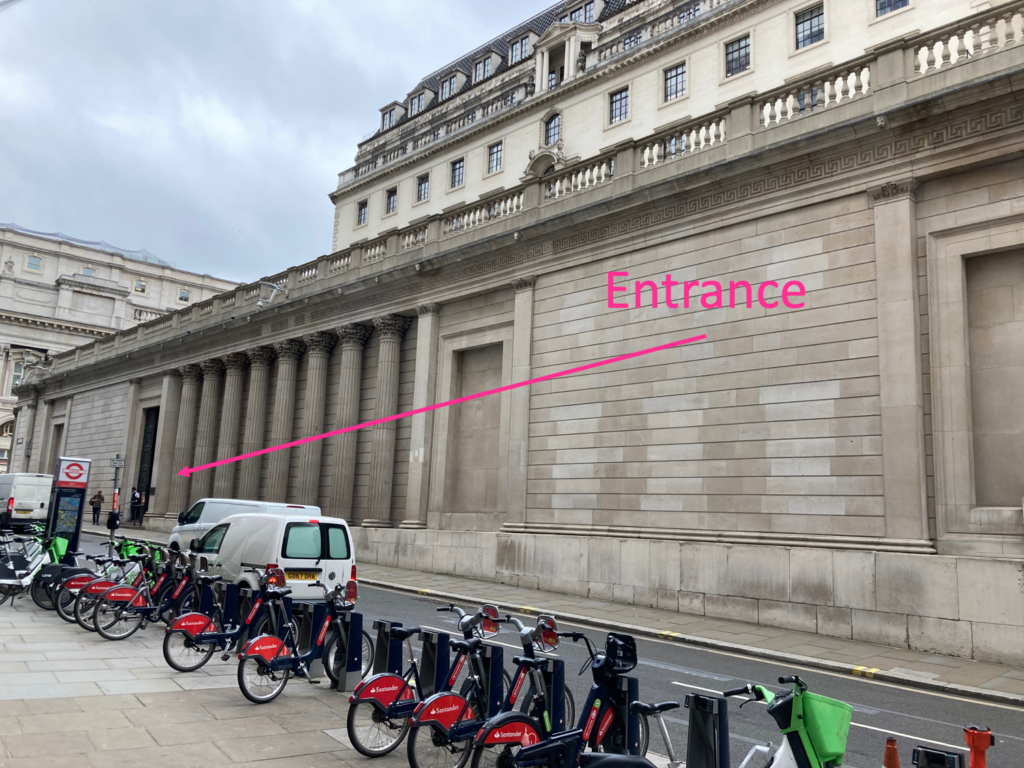
I have been to the Bank of England Museum several times and highly recommend it. It provides a good overview of the Bank’s history, contains interactive content, and has special exhibitions. Situated in the basement of the Bank (and therefore very close to the eponymous underground station) it’s open on every weekday and even opens late every third Thursday. The best part: it is totally free!
My most recent visit was in June 2024.
I started by looking at early examples of currency. Gold coins originate from c7th bc in Lydia (now in modern Turkey) and here is my photo of one of the first: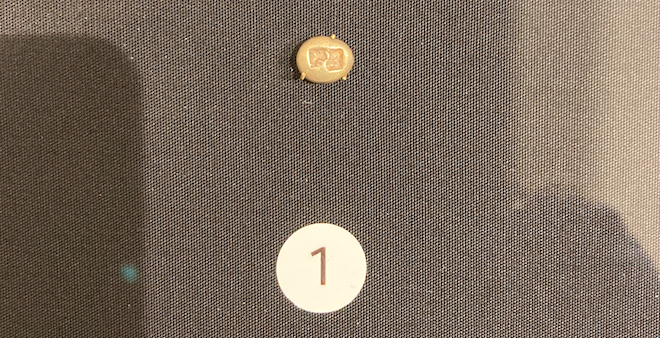
The museum has a section on the historic non monetary uses of gold. Here is a photo of a gold-plated visor from a metal workers helmet:
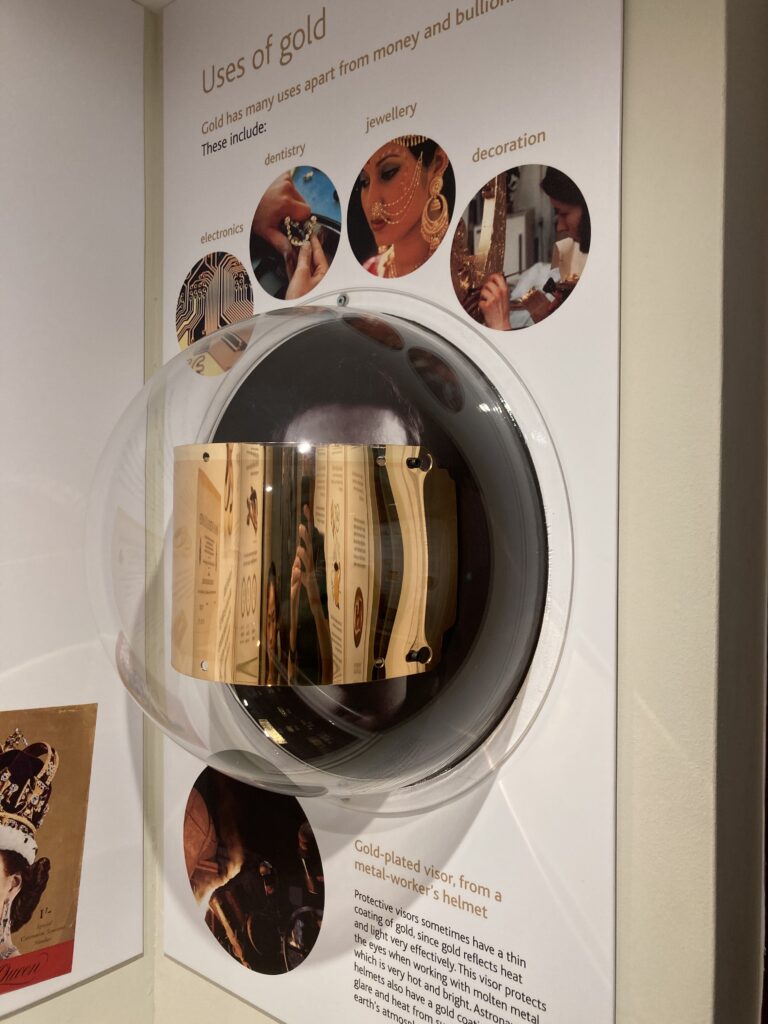
The bank’s notes originate from 1743 and the most popular types served as a type of payable receipt, that would enable the holder to redeem coin deposits. Here are some examples of early bank notes:
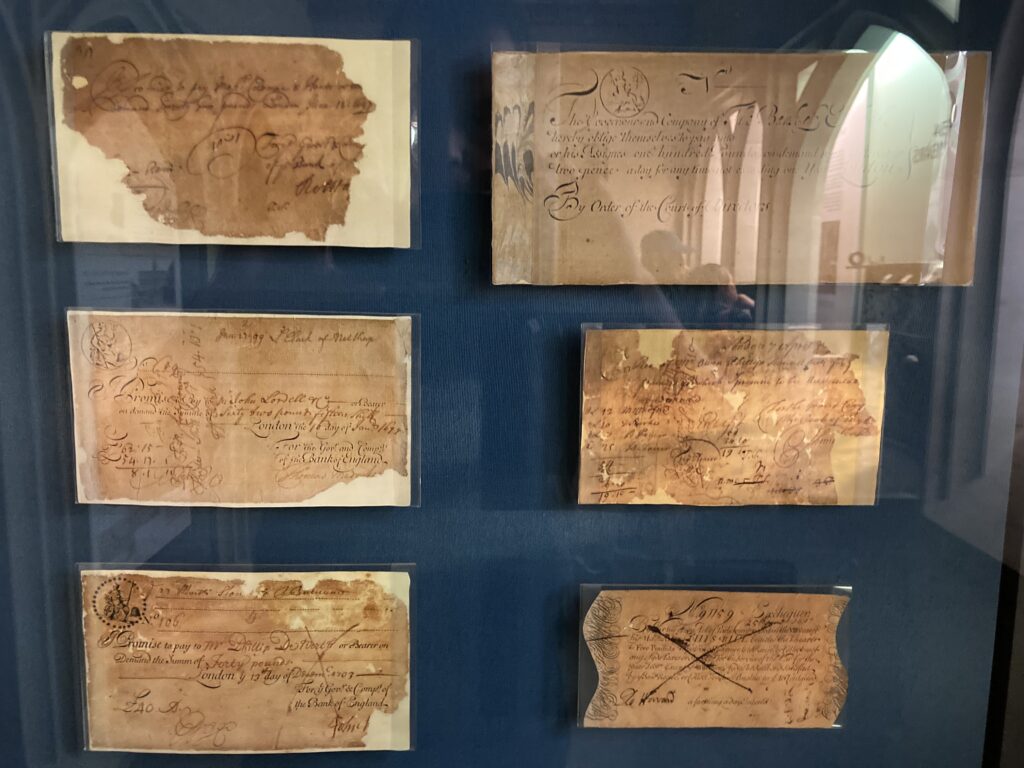 Notice how some are torn in the bottom corner. As this page explains, this shows that the balance has been paid.
Notice how some are torn in the bottom corner. As this page explains, this shows that the balance has been paid.
I was very pleased to see a section marking the history of women at the bank. The first female employees started in 1894, and the bank was one of the first institutions in the City to employ them.
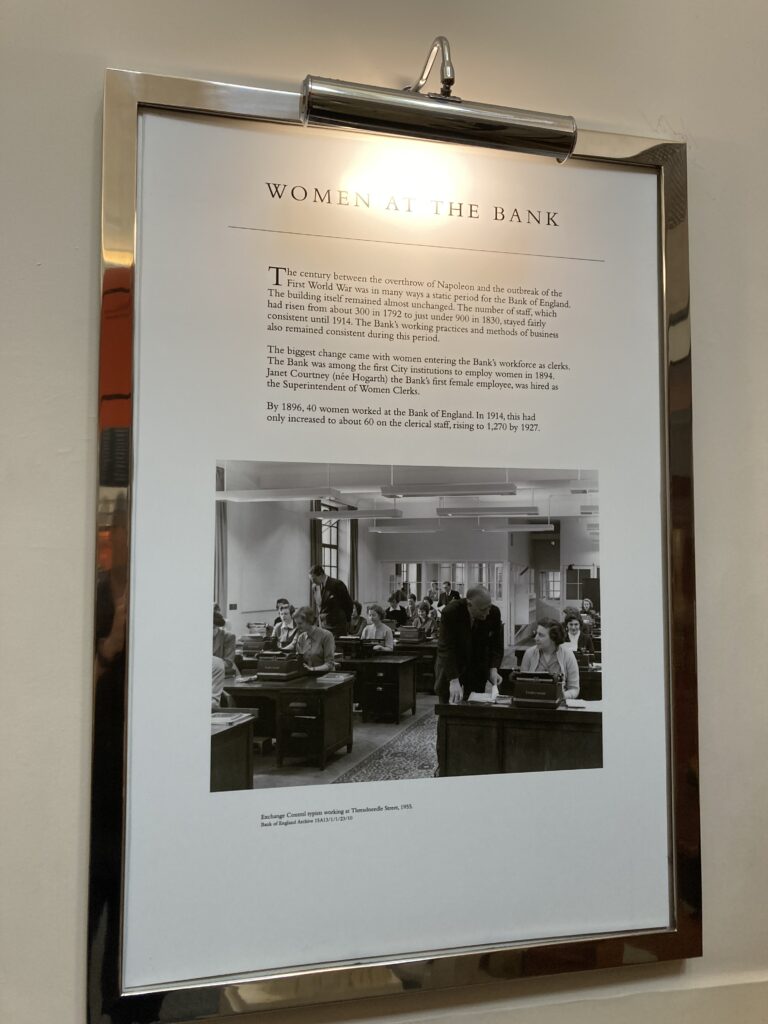
My favourite part of the museum is the attempt to explain how monetary policy works. This machine gives visitors the chance to play the role of the Monetary Policy Committee (MPC) and move interest rates up or down depending on how close inflation is to the target.

As you can see, I wasn’t very good!
But I did get it in the end!

While I was visiting there was a special exhibit on slavery and the bank. Over a 300 year period the global slave trade took over 12 million Africans from their homes, and this map reveals the scale.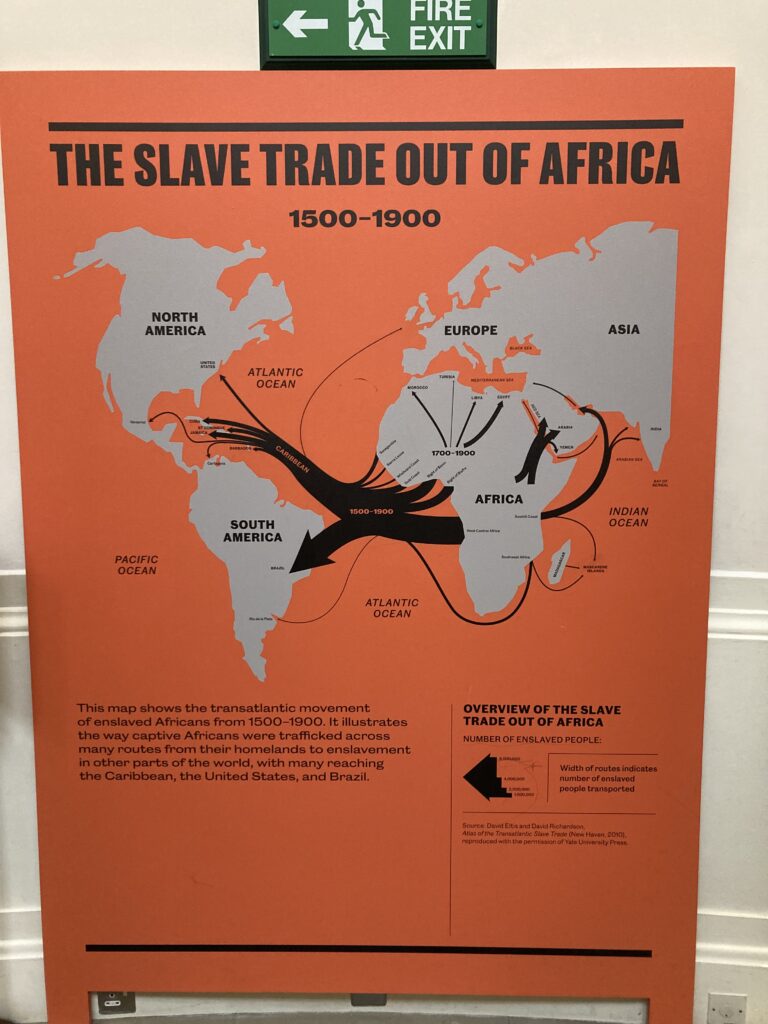
I didn’t learn much about the banks role, but I was encouraged to reflect:
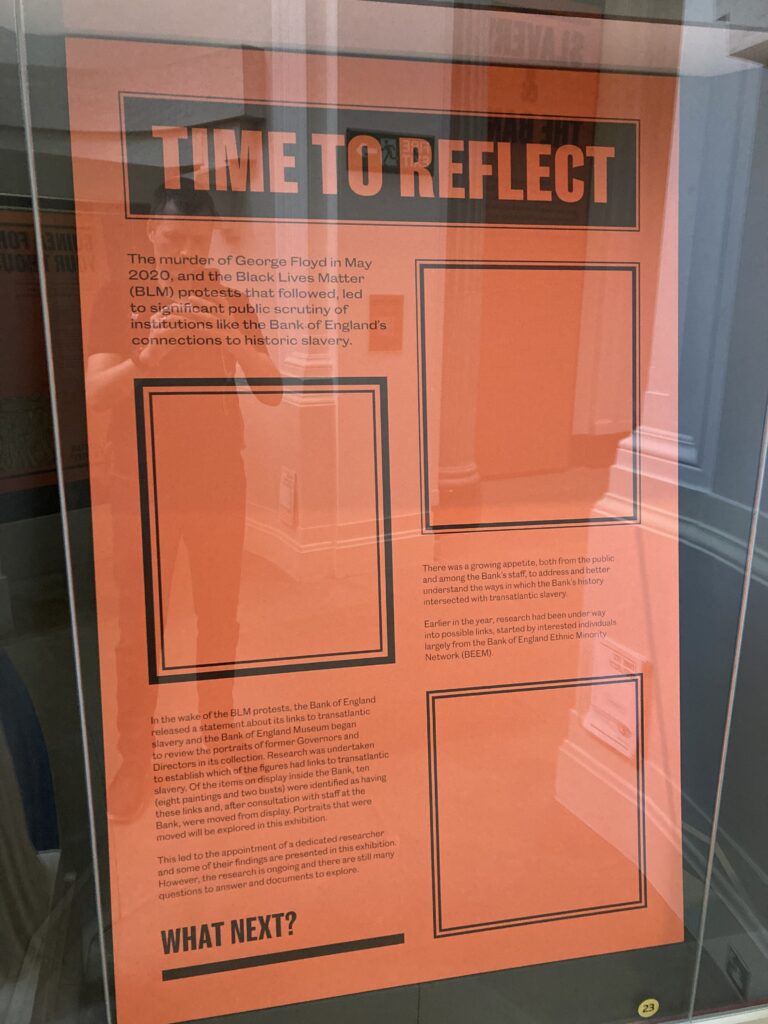
I hope you enjoyed my tour as much as I did. Please consider visiting the museum for yourself!

You can take a short quiz to test your knowledge here:
I was saddened to learn that The Museum of Neoliberalism is closing (see here). It is located near Lewisham and I visited in November 2023.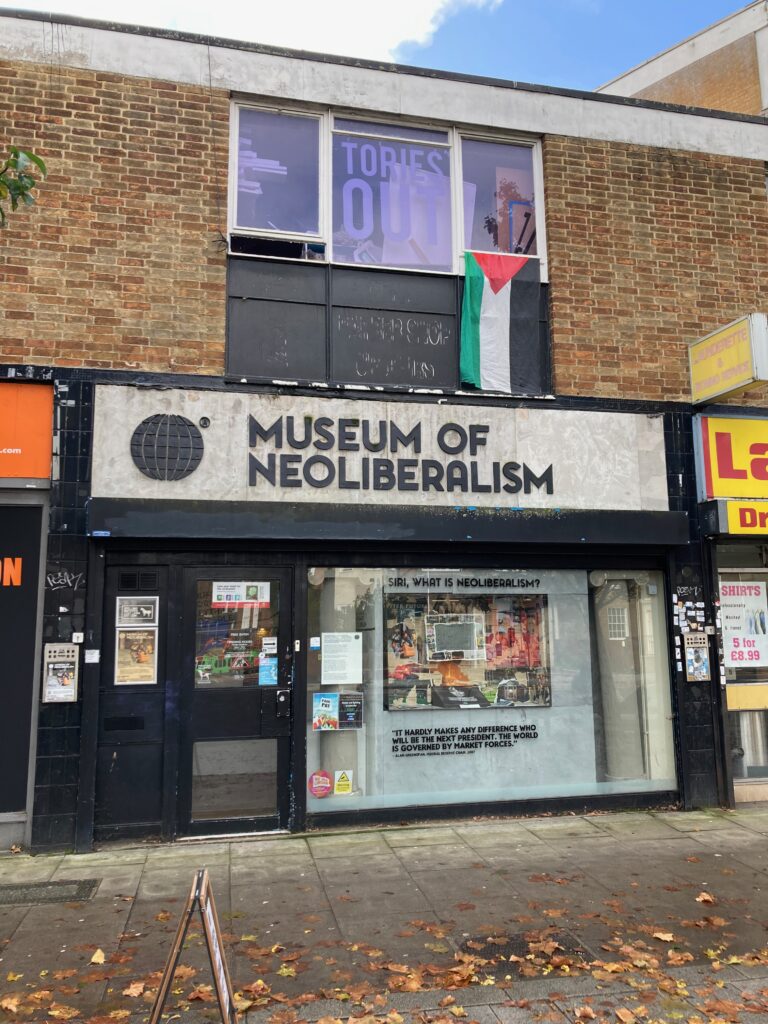
In this article I wanted to share 5 points that came to mind as I looked around.
(1) There is a tendency for critics of neoliberalism to present a conspiracy theory view of the movement. The museum presents this in the following way:
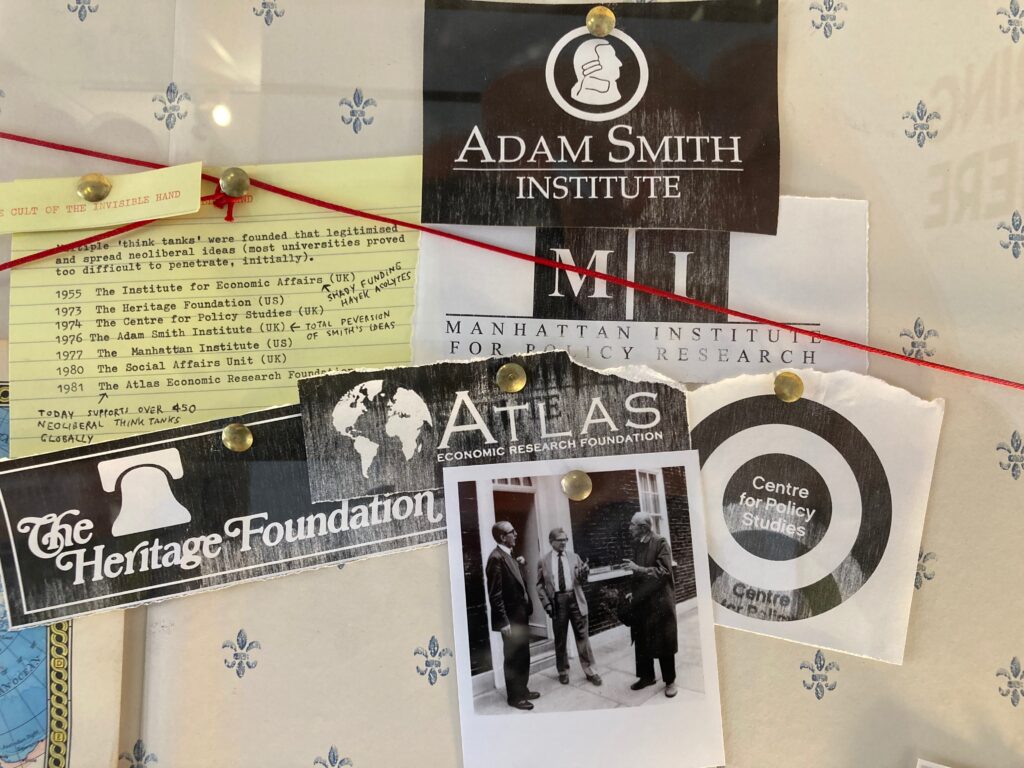
I mean, they even used red thread!
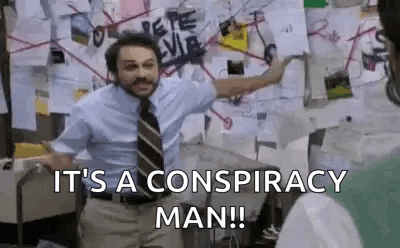
The serious point is that these outside accounts don’t match my inside knowledge, and I don’t believe that’s due to naivety on my part. I’m a senior fellow of the Adam Smith Institute and disagree that they constitute a “total perversion of Smith’s ideas”, but welcome an intellectual conversation about that claim. Back in 2016 Sam Bowman (then Executive Director at the ASI) wrote an article called “I’m a neoliberal. Maybe you are too” and yet I’ve not seen an honest engagement with them.
Ultimately, I think that the truth is less exciting than the museum depicts – these think tanks are transparent with their objectives and activities, punch above their weight in terms of resources, but have little direct power or influence. It’s an error to present them as something they are not.
(2) There is lots to be said about what has happened to economic inequality (and why) over the course of the twentieth century (my teaching materials are here). But the idea that governments responded to falling inequality by increasing prices is simply wrong. Milton Friedman’s monetarist prescriptions were a response to the prevalent inflation, and succeeded in controlling it. That inflation was a result of excessive money creation, in part due to the fiscal profligacy of government spending. The chronology is clear – neoliberalism gained dominance within the context of high inflation, and sought to combat it. It did not generate inflation as a means to reverse declining inequality.
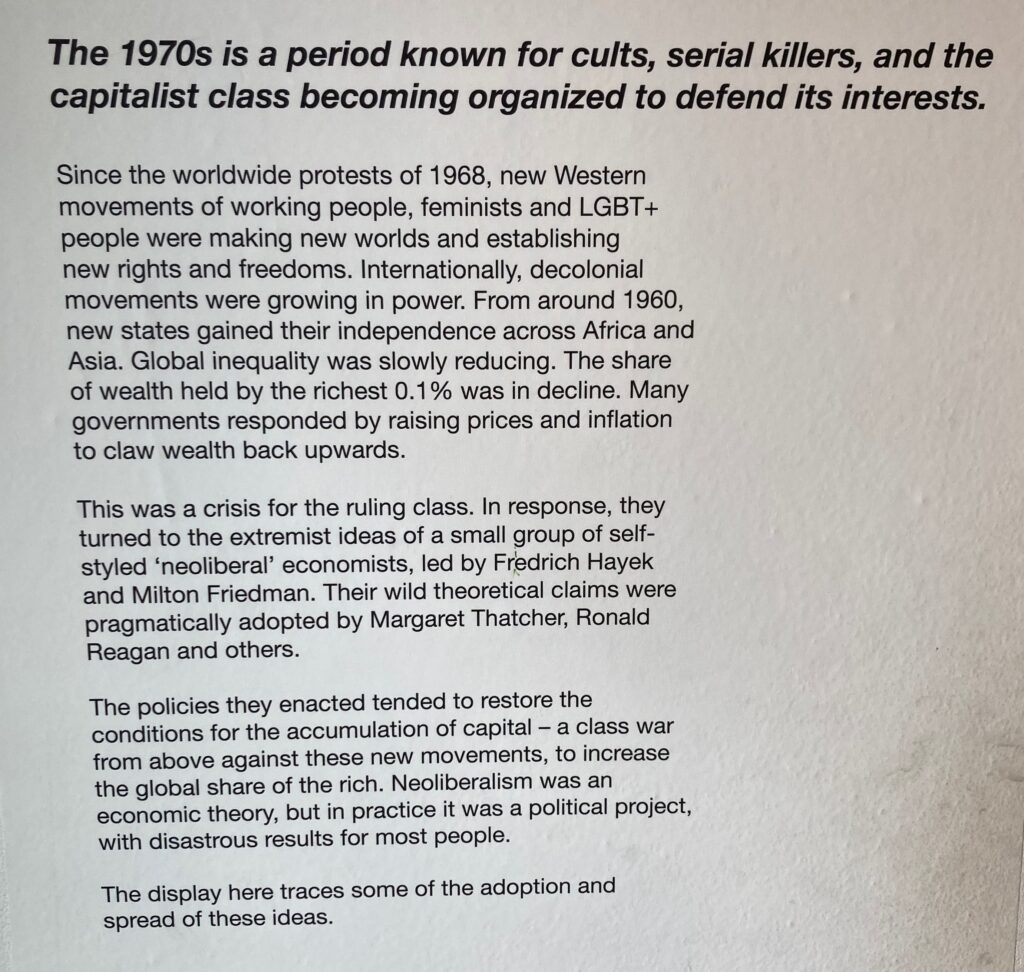
(3) There is this a long list of notable moments of privatisation in the UK. I suspect the assumption is that because people typically don’t like privatisation, this is persuasive. However, the paradox of privatization is that although most people believe that the process by which assets are returned to private ownership is often flawed, they typically do not want the state to control those industries. (Note that the solution, therefore, is to avoid nationalisation in the first place.)
But when you actually look at these companies – Lunn Poly, Thomas Cook – does anyone really want state ownership of travel agents? Is Rolls Royce really a company that the UK government has to manage and run? Really?
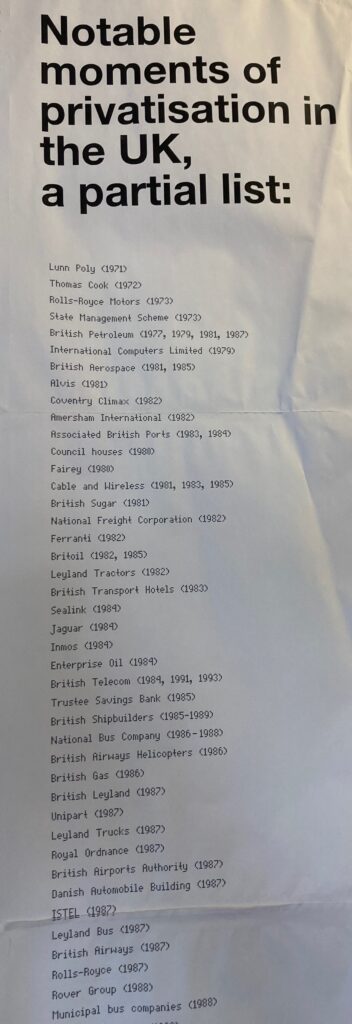
(4) The section on “bullshit jobs” exposes poor working practices and elicits sympathy for workers who lack certain employment rights. In my view, though, the last thing you should do in such situations is to take away options. And yet this is what higher labour standards, by imposing costs on employers, tend to do. Ultimately I find these sorts of judgments elitist and snobbish. There’s a million jobs I’d hate to do, but any job that someone voluntarily agrees to, because they view it as an improvement over their next best alternative, is ok by me. Generally speaking, the gig economy has been a liberation within the context of excessive restrictions on labour.
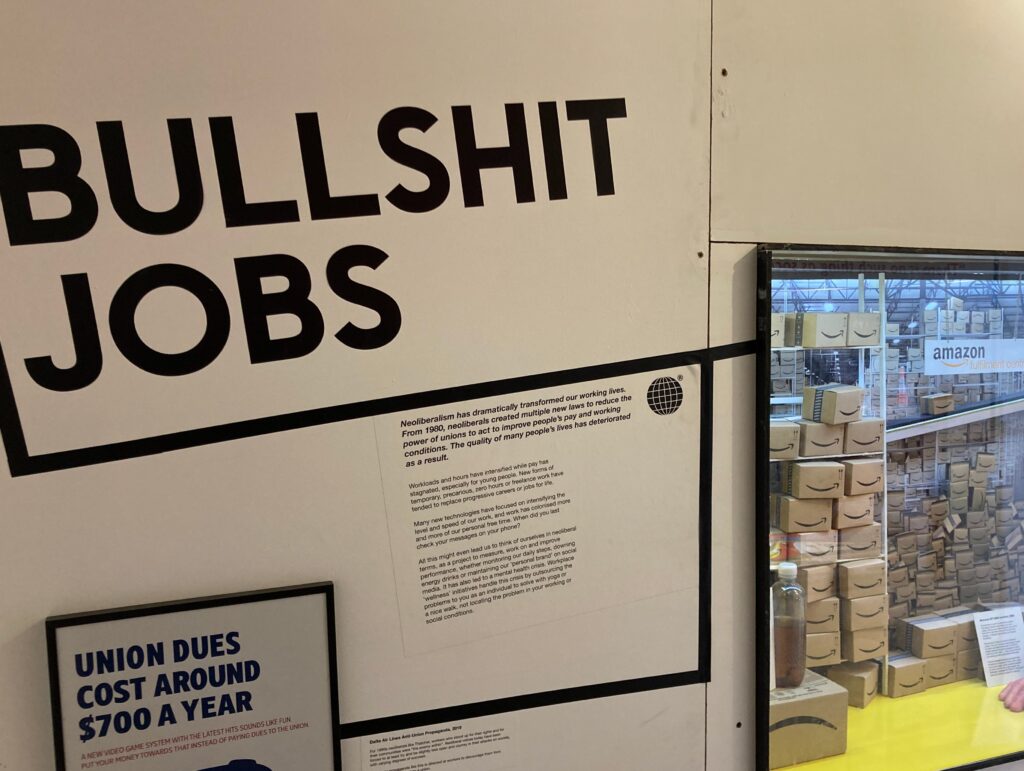
(5) And what’s the conclusion? Well this final panel, called “there is an alternative” sums things up nicely. Apparently
“the current crisis is an open moment of possibility in which the world will step beyond it into something else. What that ‘something else’ looks like is up to you.”
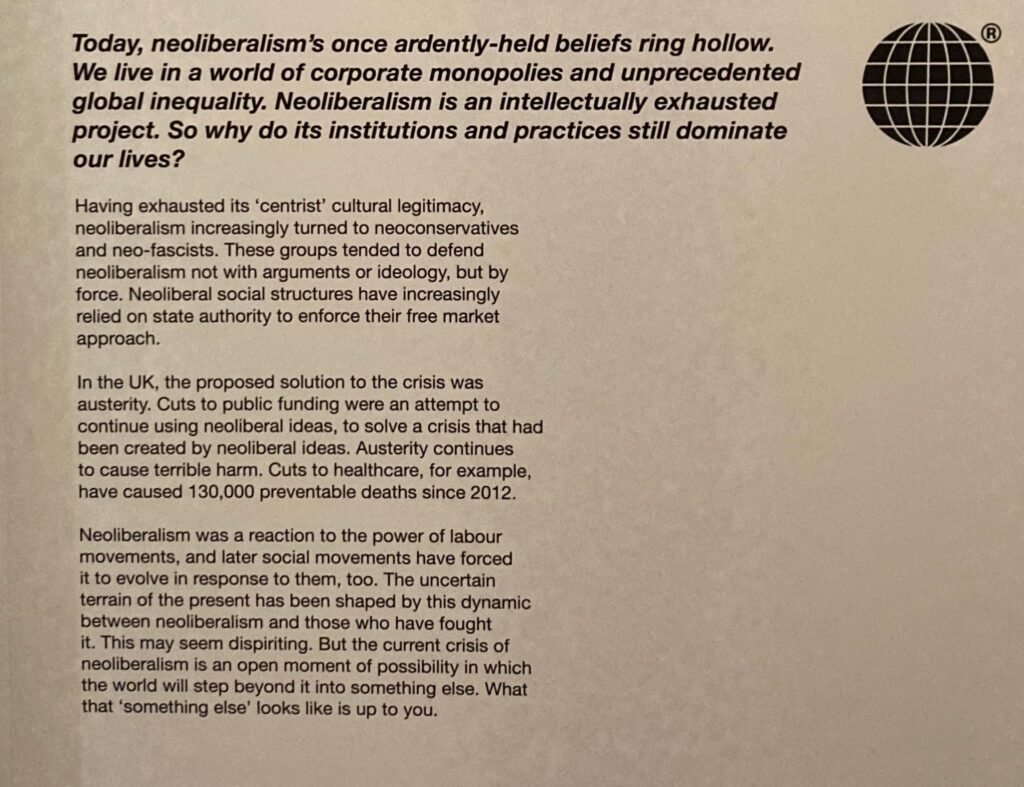
Forgive me, but I do not see an articulation of an alternative. This does nothing to dispense the fear that the alternative to a free market system of private property rights is a utopian nonsense.
I love the concept of a Museum of Neoliberalism and am sorry that it is closing. I found it provocative and hope you enjoyed my reflections.
I’ve been regularly visiting Zagreb for over a decade, and have noticed that it is unique for three main reasons:
(1) The old town – all nice European cities have an old town, but five things make Zagreb’s particularly memorable.
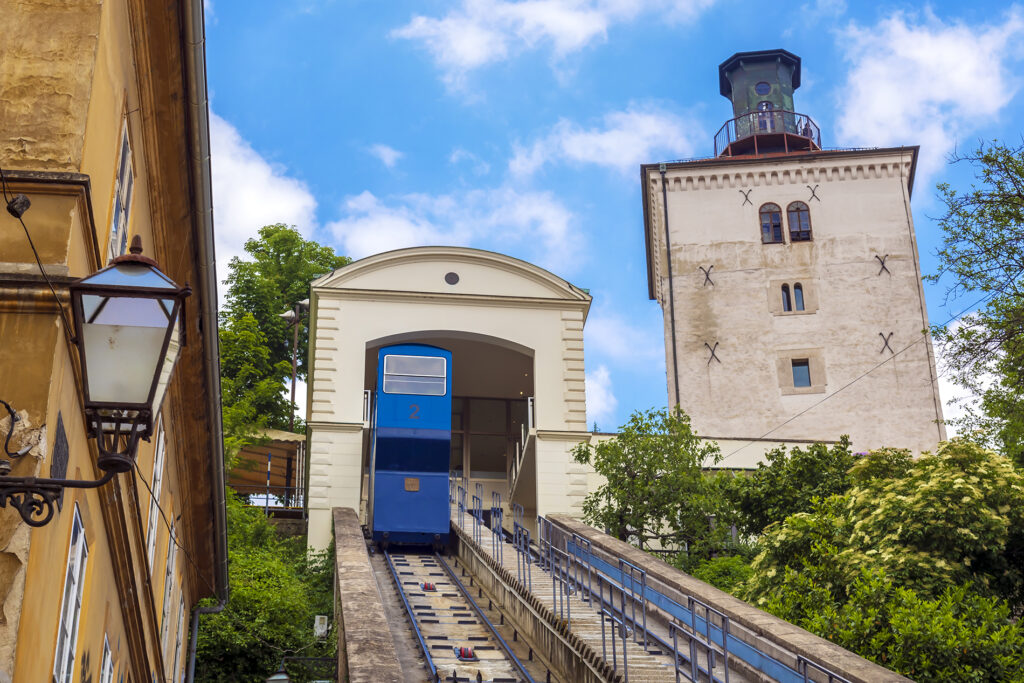
©Vladographer/Getty Images Plus
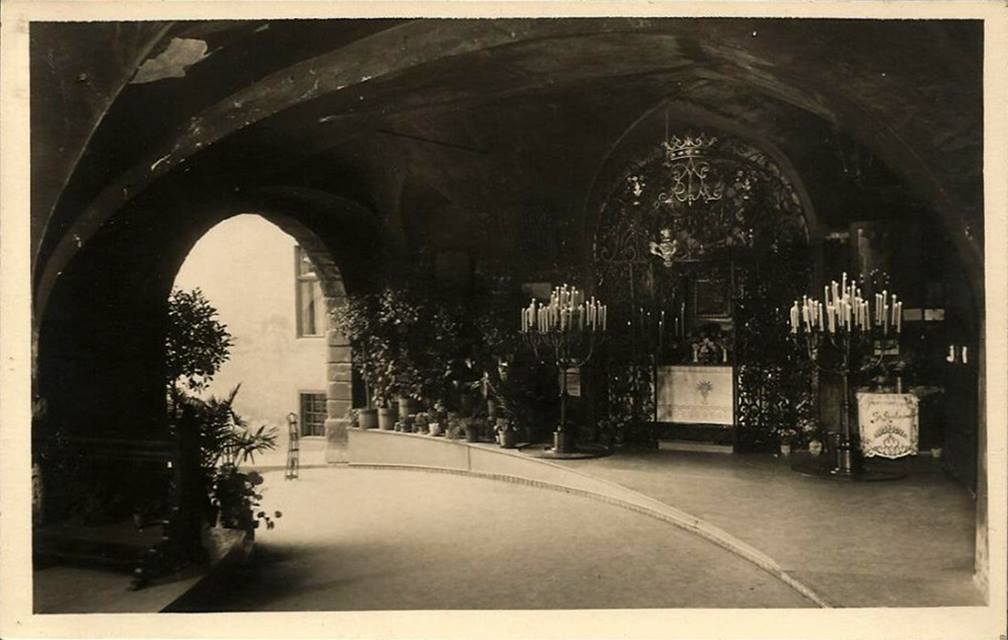
(2) Weird museums – Zagreb is home to several bizarre sounding museums, all in the centre of town. I’ve been to most, but am not sure what order to list them here. The perfect night out?
(3) Festival of light – held in March each year, the festival marks the arrival of Spring and includes installations throughout the city. The use of light in public spaces is a theme in Zagreb, as you can see from the display on the Hendrix bridge:
Finally, here are some ad hoc recommendations:
Music
Movies
Food
Zagrebačke kremšnite (from Vincek)
And here’s my favourite photo from Zagreb:

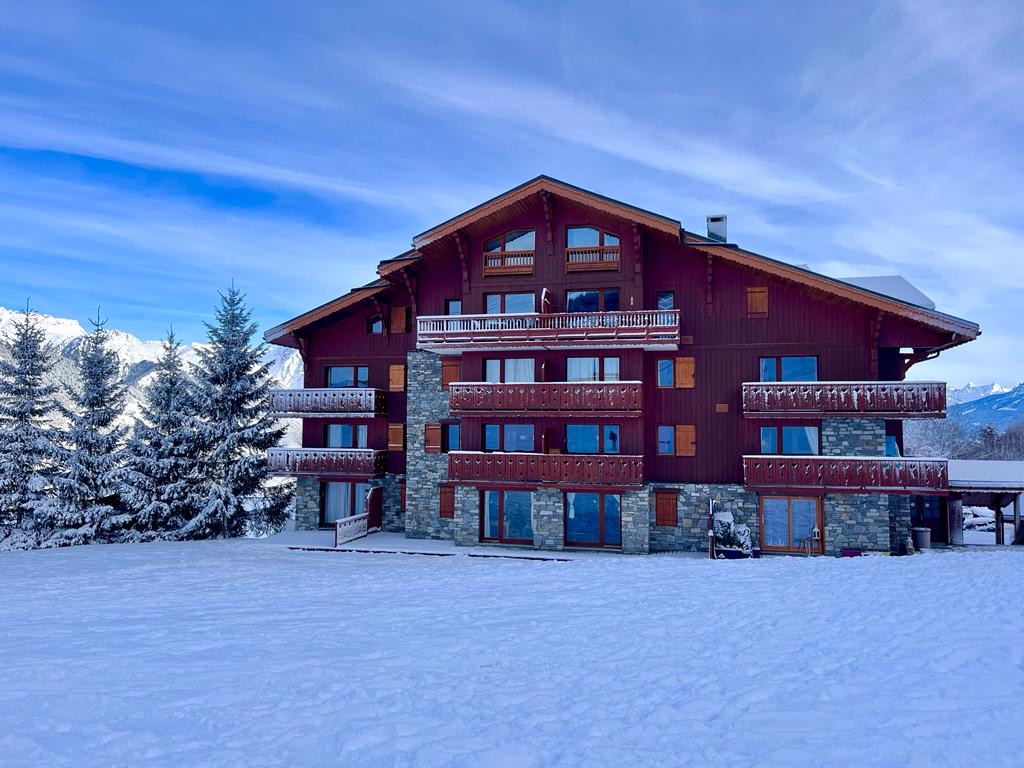 We own a fantastic 2 bedroom apartment in the family-friendly ski resort of La Plagne Montalbert. It has a master bedroom and a smaller bunk room making it perfect for a family of 4, and the sofa bed in the lounge means that it can cater for 6. Located on the second floor, the balcony overlooks the piste and provides hours of entertainment and afternoon sun.
We own a fantastic 2 bedroom apartment in the family-friendly ski resort of La Plagne Montalbert. It has a master bedroom and a smaller bunk room making it perfect for a family of 4, and the sofa bed in the lounge means that it can cater for 6. Located on the second floor, the balcony overlooks the piste and provides hours of entertainment and afternoon sun.
✈️ Montalbert is a 2 hour drive from Lyon or just over 2 hours from Geneva. Both airports are served by low cost flights with usual car rentals available.
Aime station is at the bottom of the valley (11km), and easy to reach either by taxi (15 minutes) or a regular bus service via Altibus. During the ski season there after often direct trains from St Pancras, however return journeys depart from Bourg-St-Maurice, which is twice as far away (this is because Bourg has the security equipment that allows it to have international passengers). A good option is to get a standard Eurostar to France and then change for a TGV to Aime. There is a regular (and cheap) service from Paris Gare du Lyon but you can also change at Lille, which means you avoid having to cross Paris! For more see the Man in Seat 61.
⛴️ We are 976km from Calais which is around 9 hours of driving. It can be done in one day, but France has plenty of clean and affordable hotels at convenient stops along the way. There are quick and cheap ferry services from Dover and the Eurotunnel (the quickest way to cross the channel) goes from Folkestone.
Winter
Montalbert is part of La Plagne which is world famous for its size and array of runs. Best suited for all rounders and families, there are enough black runs to challenge serious skiers but the main places are accessible via blue runs. Best of all the Vanoise Express connects La Plagne with Les Arc, providing over 400km of ski runs with 70% above 2000ft. There are 18 separate “fun zones” and new activities and lifts are added each year.

Summer
Montalbert is a charming mountain village which makes it a suitable place to vacation all year round. Outside of the ski season there are still plenty of amenities and the summer wildflowers are stunning. The gondola ski lift still operates and this allows walkers to reach the higher mountains all through the summer. Mountain bikers can take the ski lifts up several runs and enjoy the descent.
Here are a collection of slightly longer newspaper articles that I’ve found absorbing and well worth reading:
️️️ Events
⚖️ True crime
Music
For more, see Best of 2023: Personal Essays
This tour can be conducted on foot, but links to virtual resources are also provided.
55 Broadway, SW1H 0BD
This is a grade 1 art deco building near St James’ park, originally home to the London Underground. It’s not particularly tall (it’s only slightly bigger than Big Ben, and half the height of St Paul’s Cathedral) but given that it has a steel frame it is not only a skyscraper, but London’s first! (It doesn’t look like a skyscraper, but the stone encasing provides no structural integrity. Sadly, it closed in January 2020.
If you visit, try to spot the naked sculptures, Night and Day, on the outside of the building. (For controversy on this, see here).
HM Treasury, SW1A 2HQ
The Treasury is responsible for public finance and economic policy of the UK. It is located within the Government Offices in Great George Street, near Parliament Square. It has a large internal courtyard and the basement is home to the Churchill War Rooms (part of the Imperial War Museum).
Fun fact: It served as the headquarters for MI6 in the Bond movie, Spectre, and was the starting point of the street race in Fast And Furious 6.
11 Downing Street, SW1A 2AB
Next door to the most famous address in the UK (10 Downing Street is the government headquarters and traditionally the private residence of the Prime Minister), 11 Downing Street is the official residence of the Chancellor of the Exchequer. This is the equivalent of a “Minister of Finance”, which is the person responsible for fiscal policy.
Fun fact: Because the private living space is larger at no. 11 than no. 10, when Tony Blair became prime minister in 1997 he decided to live there instead. Every subsequent prime minster has done the same thing.
Take a virtual tour here: https://artsandculture.google.com/u/0/partner/10-downing-street
Bank of England, EC2R 8AH
Established in 1694 this is one of the oldest banks in the world and a model for central banks. It was nationalised in 1946. It has a monopoly on producing banknotes in England and Wales, and is responsible for the conduct of UK monetary policy.
There is an excellent museum in the basement, and several online exhibits, including this one on banknotes. The basement also houses the Bank of England vaults, which contain over 400,000 bars of gold.
Physical marketplaces are important cultural artifacts that demonstrate the importance of economic exchange for the pace and improvements of everyday living. And as Rachel Black said in her ethnographic account of Turin’s Porta Palazzo, “What other public spaces still bring together such an important cross-section of a cit’s population? What places allow for open discussion of just about any topic?” (2012, p. 38-39)
This tour can be conducted on foot, but links to virtual resources are also provided.
Portobello Market, W11 1AN
The world’s largest antique market, in the famous Notting Hill. It’s main trading day is Saturday but the area also contains numerous permanent shops. Follow on Instagram to see details of virtual fashion markets on Fridays.
Brick Lane Market, E1 6QR
Containing bric-a-brac as well as fruit and vegetables, Brick Lane market is part of London’s East End and close to the world famous cluster of curry houses. The market is is open on Sundays and can get very busy! For more information see here or here.
Smithfield Market, EC1A 9PS
Smithfield Market is technically called “London Central Markets” and is located in Farringdon. It is one of the largest wholesale meat markets in the world and the site has hosted livestock for over 800 years.
There is a 90-minute tour that costs £12.50. You can book a tour here: https://www.cityoflondonguides.com/tours/smithfield-market-tours-monthly
Fun fact: Scottish revolutionary William Wallace, otherwise known as “Braveheart”, was killed at Smithfield in 1305.
Borough Market, SE1 1TL
Borough Market is one of the oldest and largest food markets in London, dating back to the 12th century. The present buildings were built in the 1850s and house an eclectic mix of speciality foods. Open Monday – Saturday.
For a virtual tour click here.
London Metal Exchange (LME), EC2A 1AJ
The London Metal Exchange (LME) originates from 1571, but was formed in 1877 and moved to its current location in 2016. It remains one of the few physical trading floors for a major commodity market – activity is conducted within an open outcry “ring”, which gets its name from when traders would mark out a ring using chalk on a coffeehouse floor. For more on its history see here.
New York is the classic metropolis and when you stand in Times Square you feel that you are in the centre of the world.
Most great cities have a similar aspect – the river upon which it originates provides a bearing and context. I love Liverpool in part because the two Mersey tunnels preserve the unique skyline. New York – and when I say New York I obviously mean Manhattan – is special because there is no dominant waterfront. The fact that it’s an island makes it inward looking, and instead of being in a city to judge by itself, you feel that you are at the centre of all cities, and therefore all modern civilization.
My first trip to New York was via bus from Washington DC. We were offloaded in Chinatown and it was freezing cold, so we went straight into the nearest diner for coffee and doughnuts. After dumping our bags in the hostel we raced to the Empire State Building and caught the last elevator ride up. What was damp rain at street level was snowfall at the top. Romantic, and majestic.
I call myself a citizen of the world and New York the capital of the world, Jack Reacher (in Gone Tomorrow, p. 16)
My last trip was to present a paper at the Eastern Economic Association annual conference. The keynote was delivered by Ed Glaeser, the world’s leading economist on cities. He is a sharp, dazzling speaker, and watching him perform with a New York City backdrop was a thrill. Satisfying, and triumphant.
The city as the engine for social change and increasing well-being is one of the truly great triumphs of our amazing ability to form social groups and collectively take advantage of economies of scale (West, 2017, p.186).
What I love most about cities is the juxtaposition of energy and possibility and the amount of personal space they provide. An atomised city provides a certain sanctity. Here’s how to spend time alone in NYC.
Cities are the crucible of civilization, the hubs of innovation, the engines of wealth creation and centres of power, the magnets that attract creative individuals, and the stimulant for ideas, growth, and innovation. (West 2017, p.215).
The downside of this, of course, is the potential to slip out of life, unnoticed. Cities come with costs.
They are the prime loci of crime, pollution, poverty, disease, and the consumption of energy and resources. Rapid urbanization and accelerating economic development have generated multiple global challenges ranging from climate change and its environmental impacts to incipient crises in food, energy, and water availability, public health, financial markets, and the global economy (West 2017, p.215).
But surely we can agree that the solutions to these modern problems must include (i) energy efficiency; and (ii) wealth. Thus cities are crucial.
Each trip to New York is a combination of revisiting favourite eateries and seeking new ones.
I recommend:
To try:
Recommended bars:
Things to do:
I’m not sure when I’ll next go back to NYC. But I miss it.
I don’t play poker but I have a couple of friends that do. I recently asked them what resources they’d recommend for people wanting to get into it, and thought I’d share their advice.